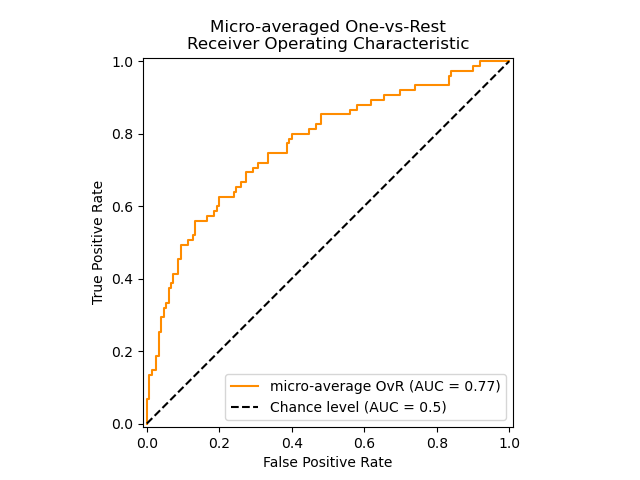python + sklearn ︱分类效果评估——acc、recall、F1、ROC、回归、距离
来源:互联网 发布:天书世界阵法1升2数据 编辑:程序博客网 时间:2024/06/06 03:36
之前提到过聚类之后,聚类质量的评价:
聚类︱python实现 六大 分群质量评估指标(兰德系数、互信息、轮廓系数)
R语言相关分类效果评估:
R语言︱分类器的性能表现评价(混淆矩阵,准确率,召回率,F1,mAP、ROC曲线)
.
一、acc、recall、F1、混淆矩阵、分类综合报告
1、准确率
第一种方式:accuracy_score
# 准确率import numpy as npfrom sklearn.metrics import accuracy_scorey_pred = [0, 2, 1, 3,9,9,8,5,8]y_true = [0, 1, 2, 3,2,6,3,5,9]accuracy_score(y_true, y_pred)Out[127]: 0.33333333333333331accuracy_score(y_true, y_pred, normalize=False) # 类似海明距离,每个类别求准确后,再求微平均Out[128]: 3第二种方式:metrics
宏平均比微平均更合理,但也不是说微平均一无是处,具体使用哪种评测机制,还是要取决于数据集中样本分布
宏平均(Macro-averaging),是先对每一个类统计指标值,然后在对所有类求算术平均值。
微平均(Micro-averaging),是对数据集中的每一个实例不分类别进行统计建立全局混淆矩阵,然后计算相应指标。(来源:谈谈评价指标中的宏平均和微平均)
from sklearn import metricsmetrics.precision_score(y_true, y_pred, average='micro') # 微平均,精确率Out[130]: 0.33333333333333331metrics.precision_score(y_true, y_pred, average='macro') # 宏平均,精确率Out[131]: 0.375metrics.precision_score(y_true, y_pred, labels=[0, 1, 2, 3], average='macro') # 指定特定分类标签的精确率Out[133]: 0.5其中average参数有五种:(None, ‘micro’, ‘macro’, ‘weighted’, ‘samples’)
.
2、召回率
metrics.recall_score(y_true, y_pred, average='micro')Out[134]: 0.33333333333333331metrics.recall_score(y_true, y_pred, average='macro')Out[135]: 0.3125.
3、F1
metrics.f1_score(y_true, y_pred, average='weighted') Out[136]: 0.37037037037037035.
4、混淆矩阵
# 混淆矩阵from sklearn.metrics import confusion_matrixconfusion_matrix(y_true, y_pred)Out[137]: array([[1, 0, 0, ..., 0, 0, 0], [0, 0, 1, ..., 0, 0, 0], [0, 1, 0, ..., 0, 0, 1], ..., [0, 0, 0, ..., 0, 0, 1], [0, 0, 0, ..., 0, 0, 0], [0, 0, 0, ..., 0, 1, 0]])横为true label 竖为predict 
.
5、 分类报告
# 分类报告:precision/recall/fi-score/均值/分类个数 from sklearn.metrics import classification_report y_true = [0, 1, 2, 2, 0] y_pred = [0, 0, 2, 2, 0] target_names = ['class 0', 'class 1', 'class 2'] print(classification_report(y_true, y_pred, target_names=target_names))其中的结果:
precision recall f1-score support class 0 0.67 1.00 0.80 2 class 1 0.00 0.00 0.00 1 class 2 1.00 1.00 1.00 2avg / total 0.67 0.80 0.72 5包含:precision/recall/fi-score/均值/分类个数
.
6、 kappa score
kappa score是一个介于(-1, 1)之间的数. score>0.8意味着好的分类;0或更低意味着不好(实际是随机标签)
from sklearn.metrics import cohen_kappa_score y_true = [2, 0, 2, 2, 0, 1] y_pred = [0, 0, 2, 2, 0, 2] cohen_kappa_score(y_true, y_pred).
二、ROC
1、计算ROC值
import numpy as np from sklearn.metrics import roc_auc_score y_true = np.array([0, 0, 1, 1]) y_scores = np.array([0.1, 0.4, 0.35, 0.8]) roc_auc_score(y_true, y_scores)2、ROC曲线
y = np.array([1, 1, 2, 2]) scores = np.array([0.1, 0.4, 0.35, 0.8]) fpr, tpr, thresholds = roc_curve(y, scores, pos_label=2)来看一个官网例子,贴部分代码,全部的code见:Receiver Operating Characteristic (ROC)
import numpy as npimport matplotlib.pyplot as pltfrom itertools import cyclefrom sklearn import svm, datasetsfrom sklearn.metrics import roc_curve, aucfrom sklearn.model_selection import train_test_splitfrom sklearn.preprocessing import label_binarizefrom sklearn.multiclass import OneVsRestClassifierfrom scipy import interp# Import some data to play withiris = datasets.load_iris()X = iris.datay = iris.target# 画图all_fpr = np.unique(np.concatenate([fpr[i] for i in range(n_classes)]))# Then interpolate all ROC curves at this pointsmean_tpr = np.zeros_like(all_fpr)for i in range(n_classes): mean_tpr += interp(all_fpr, fpr[i], tpr[i])# Finally average it and compute AUCmean_tpr /= n_classesfpr["macro"] = all_fprtpr["macro"] = mean_tprroc_auc["macro"] = auc(fpr["macro"], tpr["macro"])# Plot all ROC curvesplt.figure()plt.plot(fpr["micro"], tpr["micro"], label='micro-average ROC curve (area = {0:0.2f})' ''.format(roc_auc["micro"]), color='deeppink', linestyle=':', linewidth=4)plt.plot(fpr["macro"], tpr["macro"], label='macro-average ROC curve (area = {0:0.2f})' ''.format(roc_auc["macro"]), color='navy', linestyle=':', linewidth=4)colors = cycle(['aqua', 'darkorange', 'cornflowerblue'])for i, color in zip(range(n_classes), colors): plt.plot(fpr[i], tpr[i], color=color, lw=lw, label='ROC curve of class {0} (area = {1:0.2f})' ''.format(i, roc_auc[i]))plt.plot([0, 1], [0, 1], 'k--', lw=lw)plt.xlim([0.0, 1.0])plt.ylim([0.0, 1.05])plt.xlabel('False Positive Rate')plt.ylabel('True Positive Rate')plt.title('Some extension of Receiver operating characteristic to multi-class')plt.legend(loc="lower right")plt.show()
.
三、距离
.
1、海明距离
from sklearn.metrics import hamming_loss y_pred = [1, 2, 3, 4] y_true = [2, 2, 3, 4] hamming_loss(y_true, y_pred)0.25.
2、Jaccard距离
import numpy as np from sklearn.metrics import jaccard_similarity_score y_pred = [0, 2, 1, 3,4] y_true = [0, 1, 2, 3,4] jaccard_similarity_score(y_true, y_pred)0.5 jaccard_similarity_score(y_true, y_pred, normalize=False)2.
四、回归
1、 可释方差值(Explained variance score)
from sklearn.metrics import explained_variance_scorey_true = [3, -0.5, 2, 7] y_pred = [2.5, 0.0, 2, 8] explained_variance_score(y_true, y_pred) .
2、 平均绝对误差(Mean absolute error)
from sklearn.metrics import mean_absolute_error y_true = [3, -0.5, 2, 7] y_pred = [2.5, 0.0, 2, 8] mean_absolute_error(y_true, y_pred).
3、 均方误差(Mean squared error)
from sklearn.metrics import mean_squared_error y_true = [3, -0.5, 2, 7] y_pred = [2.5, 0.0, 2, 8] mean_squared_error(y_true, y_pred).
4、中值绝对误差(Median absolute error)
from sklearn.metrics import median_absolute_error y_true = [3, -0.5, 2, 7] y_pred = [2.5, 0.0, 2, 8] median_absolute_error(y_true, y_pred).
5、 R方值,确定系数
from sklearn.metrics import r2_score y_true = [3, -0.5, 2, 7] y_pred = [2.5, 0.0, 2, 8] r2_score(y_true, y_pred) .
参考文献:
sklearn中的模型评估
阅读全文
4 0
- python + sklearn ︱分类效果评估——acc、recall、F1、ROC、回归、距离
- sklearn工具包---分类效果评估(acc、recall、F1、ROC、回归、距离)
- 转:类效果评估——acc、recall、F1、ROC、回归、距离
- python sklearn-04:逻辑回归及其效果评估
- ROC曲线以及评估指标F1-Score, recall, precision-整理版
- 分类模型的性能评估——以SAS Logistic回归为例(2): ROC和AUC
- 分类模型的性能评估——以SAS Logistic回归为例(2): ROC和AUC
- 分类模型的性能评估——以SAS Logistic回归为例(2): ROC和AUC
- 分类模型的性能评估——以SAS Logistic回归为例(2): ROC和AUC
- ROC,AUC,Precision,Recall,F1的介绍与计算
- Precision/Recall和ROC曲线与分类
- python sklearn画ROC曲线
- python绘制precision-recall曲线、ROC曲线
- 分类之性能评估指标ROC&AUC
- 数据挖掘-分类器的ROC曲线及相关指标(ROC、AUC、ACC)详解
- Python多元线性回归-sklearn.linear_model,并对其预测结果评估
- AUC、ROC、ACC区别
- 精确率(Precision)、召回率(Recall)、F1-score、ROC、AUC
- 解决 Chrome最新版右键工具中的"编码"修改功能没有了的工具
- C语言的简单应用(四)
- 找餐饮设计公司 这些要了解透彻
- 4.关于QT中的QFile文件操作,QBuffer,Label上添加QPixmap,QByteArray和QString之间的区别,QTextStream和QDataStream的区别,QT内存映射(
- 【2-SAT+Tarjan】POJ3207 Ikki's Story IV
- python + sklearn ︱分类效果评估——acc、recall、F1、ROC、回归、距离
- HTTP(一)
- C++中的const讲解(3)---《Effective C++》
- 62、foreach与可变参数(108)
- 【算法入门】广度/宽度优先搜索(BFS)
- 227. Basic Calculator II(unsolved)
- OCP 11G 051题库解析汇总链接
- 【算法入门】A* 寻路算法具体过程及实现
- 用idea创建web项目,servlet response 等出错的原因(jsp中内置对象方法无法被解析的解决办法)


